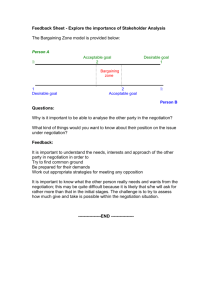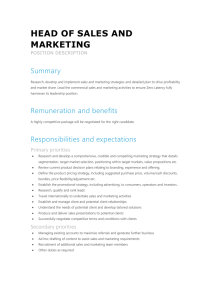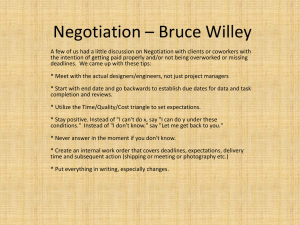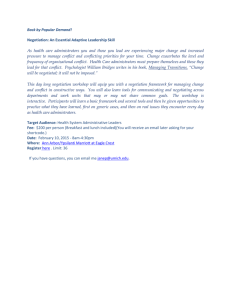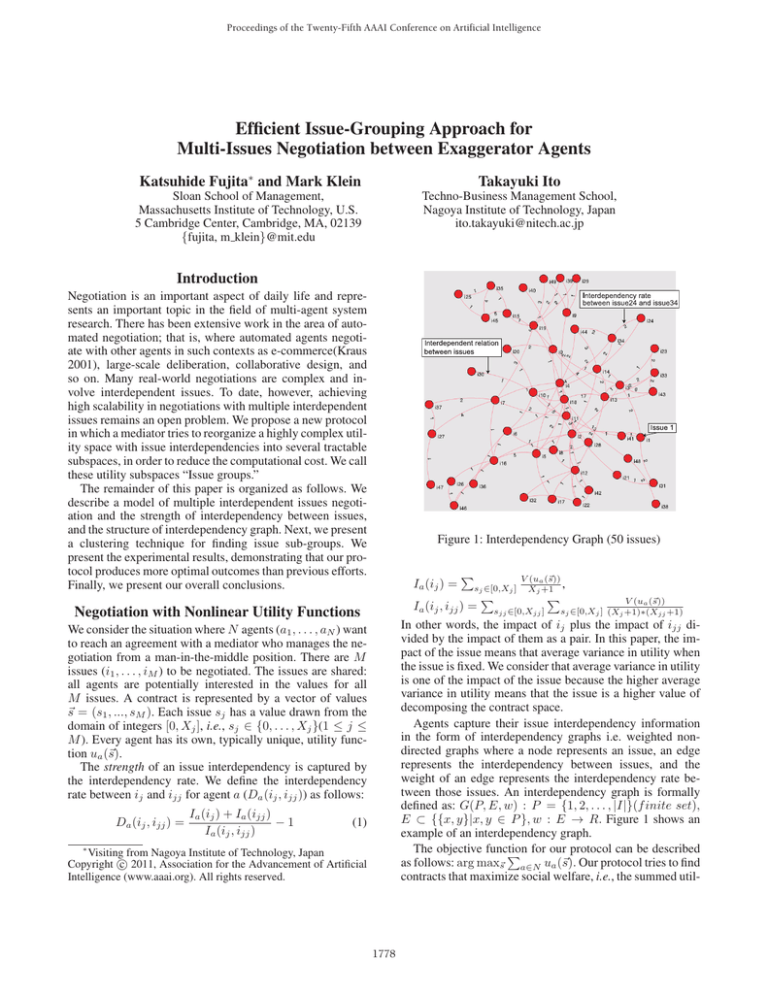
Proceedings of the Twenty-Fifth AAAI Conference on Artificial Intelligence
Efficient Issue-Grouping Approach for
Multi-Issues Negotiation between Exaggerator Agents
Katsuhide Fujita∗ and Mark Klein
Takayuki Ito
Sloan School of Management,
Massachusetts Institute of Technology, U.S.
5 Cambridge Center, Cambridge, MA, 02139
{fujita, m klein}@mit.edu
Techno-Business Management School,
Nagoya Institute of Technology, Japan
ito.takayuki@nitech.ac.jp
Introduction
Negotiation is an important aspect of daily life and represents an important topic in the field of multi-agent system
research. There has been extensive work in the area of automated negotiation; that is, where automated agents negotiate with other agents in such contexts as e-commerce(Kraus
2001), large-scale deliberation, collaborative design, and
so on. Many real-world negotiations are complex and involve interdependent issues. To date, however, achieving
high scalability in negotiations with multiple interdependent
issues remains an open problem. We propose a new protocol
in which a mediator tries to reorganize a highly complex utility space with issue interdependencies into several tractable
subspaces, in order to reduce the computational cost. We call
these utility subspaces “Issue groups.”
The remainder of this paper is organized as follows. We
describe a model of multiple interdependent issues negotiation and the strength of interdependency between issues,
and the structure of interdependency graph. Next, we present
a clustering technique for finding issue sub-groups. We
present the experimental results, demonstrating that our protocol produces more optimal outcomes than previous efforts.
Finally, we present our overall conclusions.
Figure 1: Interdependency Graph (50 issues)
Ia (ij ) =
We consider the situation where N agents (a1 , . . . , aN ) want
to reach an agreement with a mediator who manages the negotiation from a man-in-the-middle position. There are M
issues (i1 , . . . , iM ) to be negotiated. The issues are shared:
all agents are potentially interested in the values for all
M issues. A contract is represented by a vector of values
s = (s1 , ..., sM ). Each issue sj has a value drawn from the
domain of integers [0, Xj ], i.e., sj ∈ {0, . . . , Xj }(1 ≤ j ≤
M ). Every agent has its own, typically unique, utility function ua (s).
The strength of an issue interdependency is captured by
the interdependency rate. We define the interdependency
rate between ij and ijj for agent a (Da (ij , ijj )) as follows:
Ia (ij ) + Ia (ijj )
−1
Ia (ij , ijj )
sj ∈[0,Xj ]
V (ua (
s))
Xj +1 ,
s))
V (ua (
Ia (ij , ijj ) = sjj ∈[0,Xjj ] sj ∈[0,Xj ] (Xj +1)∗(X
jj +1)
In other words, the impact of ij plus the impact of ijj divided by the impact of them as a pair. In this paper, the impact of the issue means that average variance in utility when
the issue is fixed. We consider that average variance in utility
is one of the impact of the issue because the higher average
variance in utility means that the issue is a higher value of
decomposing the contract space.
Agents capture their issue interdependency information
in the form of interdependency graphs i.e. weighted nondirected graphs where a node represents an issue, an edge
represents the interdependency between issues, and the
weight of an edge represents the interdependency rate between those issues. An interdependency graph is formally
defined as: G(P, E, w) : P = {1, 2, . . . , |I|}(f inite set),
E ⊂ {{x, y}|x, y ∈ P }, w : E → R. Figure 1 shows an
example of an interdependency graph.
The objective function
for our protocol can be described
as follows: arg maxs a∈N ua (s). Our protocol tries to find
contracts that maximize social welfare, i.e., the summed util-
Negotiation with Nonlinear Utility Functions
Da (ij , ijj ) =
(1)
∗
Visiting from Nagoya Institute of Technology, Japan
c 2011, Association for the Advancement of Artificial
Copyright Intelligence (www.aaai.org). All rights reserved.
1778
ities for all agents. Such contracts, by definition, will also be
Pareto-optimal. At the same time, all the agent try to find
contracts that maximize their own welfare.
Negotiation Protocol based on Issue-Grouping
Step1: Analyzing issue interdependency. The first step is
for each agent to generate an interdependency graph by analyzing the issue interdependencies in its own utility space.
Step2: Grouping issues. The mediator employs breadthfirst search to combine the issue clusters submitted by each
agent into a consolidated set of issue groups. For example, if agent 1 submits the clusters {i1 , i2 }, {i3 , i4 , i5 }, and
agent 2 submits the clusters {i1 , i2 }, {i3 , i4 }, {i5 }, the mediator combines them to produce the issue groups {i1 , i2 },
{i3 , i4 , i5 }. In the worst case, if all the issue clusters submitted by the agents have overlapping issues, the mediator
generates the union of the clusters from all the agents.
Step3: Finding Agreements. We use a distributed variant
of simulated annealing (SA) (Russell and Norvig 2002) to
find optimal contracts in each issue group. Each agent then
votes to accept(+2), weakly accept(+1), weakly reject(-1) or
reject(-2) the new contract, based on whether it is better or
worse than the last accepted contract for that issue group.
When the mediator receives these votes, it adds them together. If the sum of the vote values from the agents is positive or zero, the proposed contract becomes the currently
accepted one for that issue group. If the vote sum is negative, the mediator will accept the contract with probability P (accept) = eΔU/T , where T is the mediator’s virtual
temperature and ΔU is the utility change between the contracts. If the proposed contract is not accepted, a mutation of
the most recently accepted contract is proposed in the next
round. This continues over many rounds.
Figure 2: Comparison of optimality
applied. The number of limitation of ‘strong’ votes is 250
which is the optimal number of limitations in this experiments. (D) is the method presented in (Klein et al. 2003),
using a simulated annealing protocol based on the agents’
votes without generating issue-groups.
Figure 2 compares the optimality rate in the sparse connection and dense connection cases. (A) achieved a higher
optimality rate than (D) which means that the issue-grouping
method produces better results for the same amount of computational effort. The optimality rate of the (A) condition
decreased as the number of issues (and therefore the size of
the search space) increased. (B) is worse than (A) because
the exaggerator agents generate reduced social welfares in
multi-agents situations. However, (C) outperforms (B) the
limitation of ‘strong’ votes is effective of improving the social welfare reduced by the Exaggerator Agents.
Exaggerator Agents
Conclusion
Any voting scheme introduces the potential for strategic
non-truthful voting by the agents, and our method is no
exception. For example, most of the agents’ votes are always “strong,” the final social welfare is reduced(Klein et al.
2003). What we need is an enhancement of our negotiation
protocol that preventing the exaggerator votes and maximizing social welfare. We guess that simply placing a limit on
the number of “strong” votes each agent can work well as
the experimental results show.
In this paper, we proposed a new negotiation protocol, based
on grouping issues, which can find high-quality agreements
in interdependent issue negotiation. We demonstrated that
our proposed protocol results in a higher optimality rate than
methods that don’t use issue grouping. In addition, the limitation of “strong” votes is effective of improving the reduced
social welfare between exaggerators.
References
Ito, T.; Hattori, H.; and Klein, M. 2007. Multi-issue negotiation
protocol for agents : Exploring nonlinear utility spaces. In Proc. of
IJCAI-2007, 1347–1352.
Klein, M.; Faratin, P.; Sayama, H.; and Bar-Yam, Y. 2003. Negotiating complex contracts. Group Decision and Negotiation
12(2):58–73.
Kraus, S. 2001. Strategic Negotiation in Multiagent Environments.
Cambridge University Press.
Russell, S. J., and Norvig, P. 2002. Artificial Intelligence : A Modern Approach. Prentice Hall.
Experimental Results
We conducted several experiments to evaluate our approach.
In each experiment, we ran 100 negotiations. The following
parameters of the utility functions were same setting as (Ito,
Hattori, and Klein 2007). We compared the following negotiation methods: (A) applies the simulated annealing protocol based on the agents’ votes, and performs the negotiation
separately for each one of the issue groups, and combines the
resulting sub-agreements to produce the final agreement. All
agents tell the truth votes. (B) applies the simulated annealing protocol based on the agents’ votes with issue-grouping.
“All agents” tell the exaggerator votes. (C) is same situation with (B). However, the limitation of ‘strong’ votes is
1779

